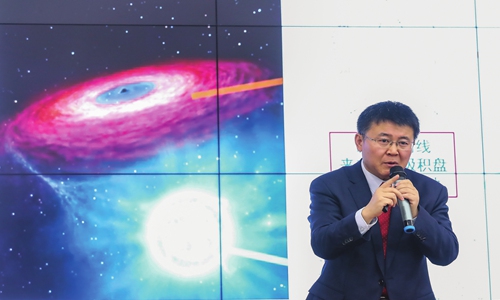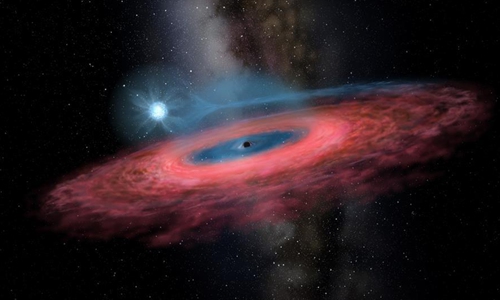HOME >> CHINA
Massive stellar black hole discovered by Chinese-led team
By Xu Keyue Source:Global Times Published: 2019/11/28 23:13:40
Discovery topples previous assumptions on black hole formations: scientists

A Chinese-led research team has discovered a surprisingly huge stellar black hole about 15,000 light years from Earth with a mass 70 times greater than the Sun. Researchers named the hole LB-1. Photo: Xinhua
A Chinese-led scientific team said Thursday that they have discovered a massive stellar black hole, 70 times greater than the Sun, stirring enthusiastic talk among Chinese internet users that a Nobel Prize should recognize the achievement.
A new Chinese telescope in North China spotted a hole "twice as massive as what we thought possible," the researchers said in a statement released on Thursday, and upending many previous assumptions about stellar evolution and black hole formation. The hole, named LB-1 by an international research team headed by Liu Jifeng of the Beijing-based National Astronomical Observatory of China (NAOC) at the Chinese Academy of Sciences, is 15,000 light years from Earth.
The team discovered the black hole with the Large Sky Area Multi-Object Fiber Spectroscopic Telescope (LAMOST), an observatory independently developed by China and located in Xinglong county, Hebei Province.
Liu said if they used an ordinary 4-meter telescope it might have taken 40 years to find the hole.
The team is comprised of scientists from China, the US, Spain, Australia, Italy, Poland and the Netherlands.
That Chinese scientists lead an international team reflects not only the country's rising power in astronomy, but also the country's open attitude towards international cooperation, Li Miao, director of the physics department of Southern University of Science and Technology in Shenzhen, told the Global Times .
The breakthrough, rooted in the telescope system, is encouraging for Chinese astronomers as it promises possible findings of yet more black holes, Li said.
After the initial LAMOST discovery, the world's largest optical telescopes - Spain's 10.4-meter Gran Telescopio Canarias and the 10-meter Keck I telescope in the US - were used to determine the system's physical parameters: a star eight times heavier than the Sun orbiting a 70-solar-mass black hole every 79 days.
"Black holes of such a mass should not even exist in our galaxy, according to most of the current models of stellar evolution," Liu said.
"Now theorists will have to take up the challenge of explaining its formation. The discovery came as a big surprise," Liu said.
Scientists had estimated the mass of an individual stellar black hole in the galaxy as no more than 20 times that of the Sun, but the discovery toppled that assumption, the statement said.
"This discovery forces us to re-examine our models of how stellar-mass black holes form," said Laser Interferometer Gravitational Wave Observatory (LIGO) director David Reitze, from the University of Florida.

Photo:Xinhua
Nobel Prize banter
The discovery made a splash on Chinese social media with many internet users congratulating the team on the breakthrough.
The topic "the massive-ever stellar black hole" has been was viewed more than 20 million times as of press time.
Users said the achievement was worthy of a Nobel like the 2017 prize in physics awarded to LIGO black hole researchers.
Rainer Weiss and Kip Thorne, both of the California Institute of Technology, were awarded the Nobel Prize in Physics in October 2017 for the discovery of ripples in space-time known as gravitational waves, which were predicted by Albert Einstein a century ago but never directly seen.
The first image of a black hole was captured in April 2017 when scientists used telescope observations of the center of the galaxy M87. The image showed a bright ring formed by light bending in the intense gravity around a black hole 6.5 billion times more massive than the Sun.
This long-sought image provided strong evidence for the existence of super massive black holes and opened a new window on the study of black holes, their event horizons and gravity.
Deng Xiaoci contributed to this story
Posted in: SOCIETY